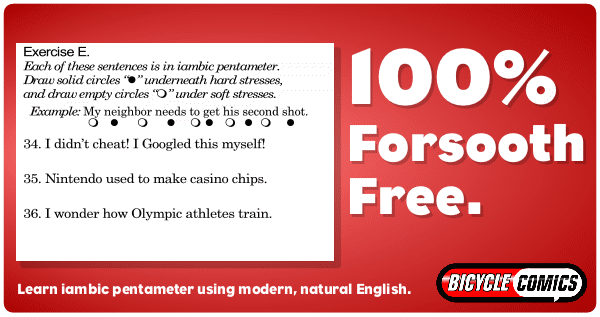Poor understanding of pentameter and stress results in bad formal poetry and funky song lyrics. For students grappling with a Shakespeare play— such as Othello, Hamlet, or MacBeth—the underlying rhythms hold the key to deeper comprehension of the texts.
The previous sentence was a quatrain of iambic pentameter, by the way. But you caught that, right? Good job!
Our classroom worksheets provide a systematic approach to iambic pentameter. They start with single words, then phrases, then lines. Students hum, they clap their hands, they tap their pencils…and slowly they discern the hidden sounds. Nearly 50 (fifty!) short questions allow teachers and educators to assess who is getting it and who needs some help. For further practice, we offer sonnet puzzles, a fun way to involve children with kinesthetic learning styles.

Foundations of the Sonnet: Iambic Pentameter starts from a basic question:
Do you pronounce the word invent as "IN-vent" or "in-VENT"?
It builds from there with over 50 exercises designed to get high-school and advanced middle-school students thinking about stress, intonation, and rhythm. No prior experience with sonnets or poetry is presumed. Our lesson plan prepares students for Shakespeare, Shelley, Milton, and Browning. As of December 2020, over 400 teachers and professors have used our worksheets in their classrooms.
We offer these worksheets in two distinct editions, both equally rigorous. Both editions contain detailed explanations and numerous examples. Both editions use iambic pentameter to form common, conversational English sentences such as
Nintendo used to make casino chips.
and
This isn't where I left my bicycle!
Each edition has a distinct set of 50 questions for students to complete. The only significant difference between the two editions is how teachers can obtain the specific answer keys.
The Premium Edition worksheets are free to download. The teacher's answer key costs $8.
download Premium Worksheets (PDF) 
The Free Edition worksheets are also free to download. These are just as rigorous and educational as the Premium Edition, but the questions are different. (So the Premium answer key sold above will not help on the Free Edition.) To obtain an answer key, teachers must write to us from their official school E-mail accounts. We will take common-sense steps to verify your identity before we send answer keys. These answer keys are coded to each teacher. (The existence of SparkNotes has not escaped our notice.)
Possibly the best idea we've ever had, sonnet puzzles allow students to experiment with the structure and rules of a traditional Shakespearean sonnet without the added stress of writing a sonnet (that comes later).
Puzzle sets will take about 10 minutes of prep time before class. Each puzzle set will occupy a group of 3-5 students. Teachers will need a decent laser or ink-jet printer, pastel office paper or cardstock (cardstock recommended), and a pair of scissors. All necessary instructions are on the PDF. Sonnet puzzles offer students an unforgettably fun classroom activity that helps them apply their worksheet exercises to a canonical work of English literature. You are seriously missing out if you pass these up!
Percy Bysse Shelley wrote "Ozymandias," one of the most popular poems in the English canon, as half of a competition with his friend, the poet Horace Smith. Our Ozymandias close-reading worksheet invites students to compare and contrast these two similar poems and explore why one became an enduring poetry hit. With language from the 1800s, these poems may also serve as helpful "bridges" to the older English of Shakespearean sonnets. This poetry lesson plan suits students in grades 8 and up.
(Answer key is coming soon.)
Of course, we're not the only source of great content to help introduce high school and middle school students to classic English poetry and prosody. Here are some links that may be of use to teachers and educators as they develop a school poetry unit that celebrates this classic verse structure.
Written during the first weeks of the Novel Coronavirus's outbreak in North America, the poems of In Absentia document cultures on the cusp of devastation. Featuring new poetry by sam sax, Drew Pham, Laura Brown-Lavoie, and more than a dozen others.(Learn more)
Lady Gregory's classic Irish play offers a startlingly relevant take on the tension between police power and political violence. Our Ebook bundles a full set of teaching resources, worksheets, and present-day criticism.